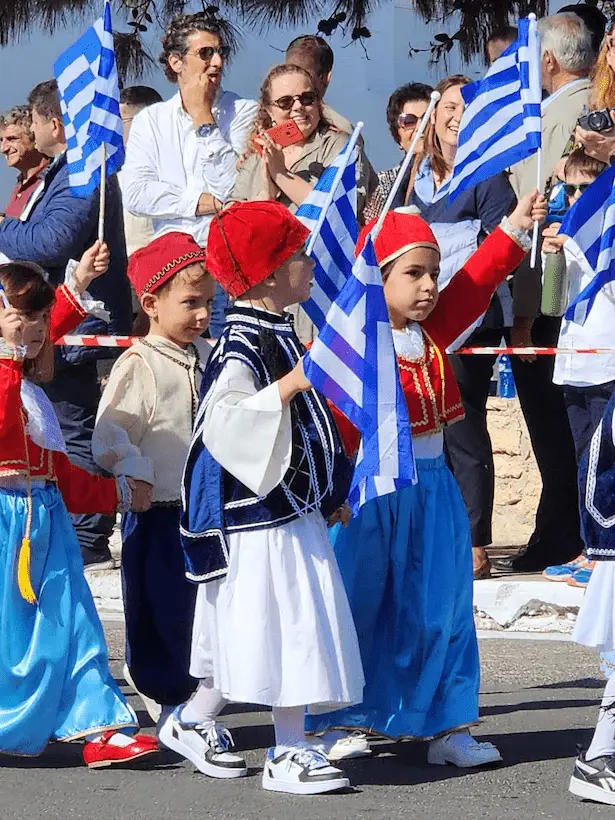George Blessas, the youngest of five siblings, was born in Argostoli, Kefalonia on October 19, 1905. His parents were Panagis Blessas and Anna Blessas, née Assani, both from old families of the island. George Blessas remained unmarried. Before the war, he had a serious relationship that could have led to marriage, but the Austrian nationality of the young woman, combined with the declaration of war, ended the relationship. He spent his early school years in Argostoli and at the age of 12 enrolled in the Ionian School of Athens. In August 1919, he was admitted among the first to the Naval Cadet School. In October 1923, as a graduate cadet, he served on the fast cruiser ELLH and took part in operations supporting the withdrawal of our troops from Asia Minor.

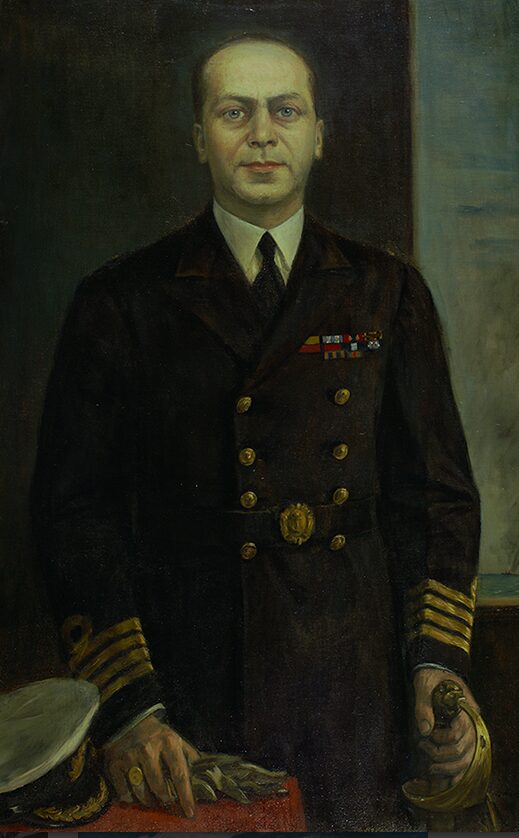
He was appointed Ensign in December 1923 and Sub-Lieutenant in September 1926 and in these ranks served on the most formidable ships of our Fleet, such as the battleships “KILKIS”, “LIMNOS”, “AVEROF”, fast cruiser “ELLH” and others. From September 1929 to January 1936 he served on submarines, where in January 1931 he was promoted to Lieutenant and in September 1935 to Lieutenant Commander. As Commander he served on the submarines “PAPANIKOLIS” and “TRITON”. As Lieutenant Commander he served on the destroyer “YDRA”, Commander of the torpedo boat “PERGAMOS”, Adjutant to the Fleet Commander Rear Admiral D. Oikonomou and in December 1938 was appointed Executive Officer on the destroyer “VASILEUS GEORGIOS” under construction in Glasgow. The declaration of war in 1940 found him Commander of the torpedo boat “KYDONIAI”, which had been assigned to the Naval Defense Area of Patras.
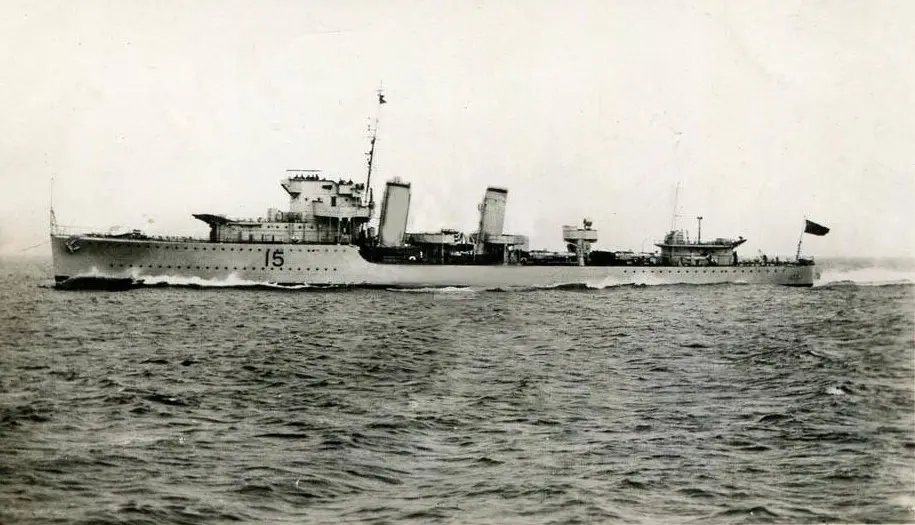
In early October 1942, the destroyer “VASILISSA OLGA” joined the 14th Squadron of British Destroyers and carried out convoy escorts from Alexandria to Malta, during which many warships and merchant ships were decimated by planes and submarines, especially in the leg of the journey after Tobruk.
The moment of its first great success arrived at 03:00 on December 15, 1942, when, in cooperation with the British destroyer “PETARD”, and while 40 miles south of Malta, they sank the Italian submarine “UARSCIEK”. The British ship launched a depth charge attack and then the “VASILISSA OLGA” detected a submarine echo, sailed rapidly to the area and dropped six depth charges. However, the Greek destroyer was forced to interrupt the attack due to a crossing of the attack course against the submarine with the “PETARD”.
While the “VASILISSA OLGA” was transmitting the contact details of the enemy submarine to the “PETARD”, it suddenly surfaced. Then the British destroyer turned on its searchlight and began firing its gun at the submarine, which returned fire. The distance between the two ships was so small that they briefly collided lightly. After a while, the “PETARD” ceased fire, while the crew of the Greek destroyer realized that the crew of the submarine had abandoned it and had fallen into the sea. Three officers, four non-commissioned officers and 21 sailors were captured, proving that it was the Italian “UARSCIEK”, while the British ship had sent a landing party with the aim of capturing the ship and towing it to Malta.
From the analysis of the attack carried out in Malta and from the interrogations of the survivors, including the submarine’s executive officer, it was ascertained that the series of depth charges from the Greek destroyer had critically damaged the submarine, causing leaks and forcing it to surface. It was also found that the “UARSCIEK”, before being attacked, had fired an unsuccessful salvo of two torpedoes at the “OLGA”.In order to personally congratulate the commander and crew of the “VASILISSA OLGA”, the Commander-in-Chief of the British Mediterranean Fleet boarded the Greek destroyer, while after about a month the King of England awarded the commander of the ship, Lieutenant Commander George Blessas, the highest reward, the Distinguished Service Order medal, the famous D.S.O. Thus, Blessas became the first Greek Naval Officer to receive this great distinction. From the Greek side, he was awarded the War Cross of the 3rd Class.
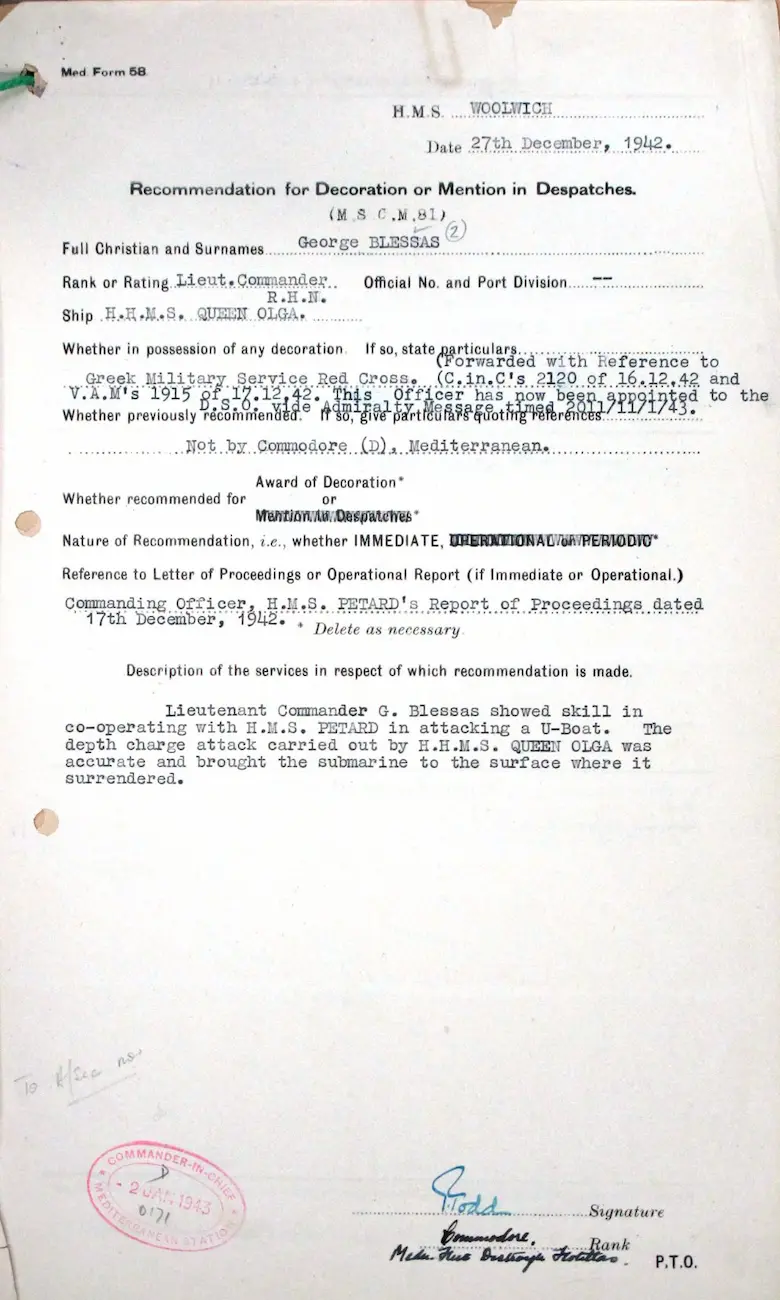
On the night of January 18, 1943, “VASILISSA OLGA”, along with the British destroyers “PAKENHAM” and “NUBIAN”, located near the Cape of Tunis the equipped Italian auxiliary “STROMBOLI”, loaded with oil. “VASILISSA OLGA” fired two broadsides, the first of which, as stated in the official British report, hit the enemy ship with exceptional success, causing it to start burning. After this new success, for which Blessas was awarded the War Cross of the 3rd Class for the second time, the name of “VASILISSA OLGA” became known and respected in the Allied Fleet. Also, the belief in the “lucky charm” that the new Commander brought to the ship was strengthened.
On March 30, 1943, “VASILISSA OLGA” sailed to Benghazi to pick up troops and, following orders from the British Naval Commander there, a pilot boarded the ship to guide it within the harbor, among the many and numerous wrecks of unknown location. Upon exiting the harbor, the ship’s starboard propeller struck a wreck, which the guide was unaware of. The damage caused, however, did not prevent “VASILISSA OLGA” from continuing its journey to Tripoli.
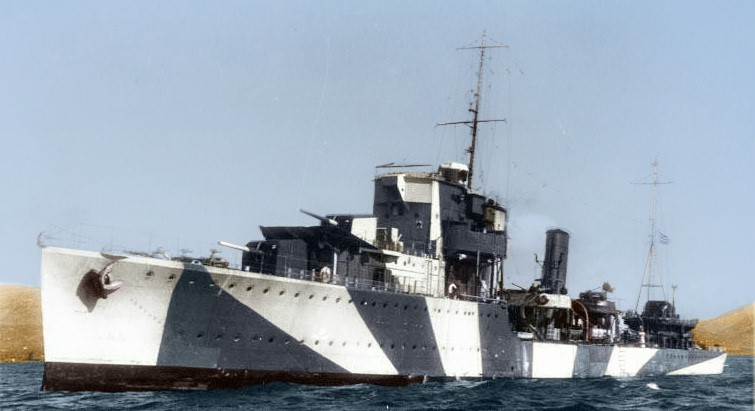
On the night of June 1/2, 1943, “VASILISSA OLGA” and the equally famous for its action in the Mediterranean British destroyer “JERVIS” sailed, located, and engaged an enemy convoy consisting of two merchant ships, an escort, and a torpedo boat, at a distance of only four miles from the southern tip of the Italian coast, Cape Spartivento. During the engagement, the ship’s Executive Officer and Artillery Officer, Sub-Lieutenant M. Grigoropoulos, with the second broadside hit one of the enemy merchant ships, which immediately caught fire. The combined fire of the two destroyers focused on the other merchant ship, while the British “JERVIS” sank the Italian torpedo boat. For this success, on the Greek side, Blessas was awarded the Silver Cross of Bravery.
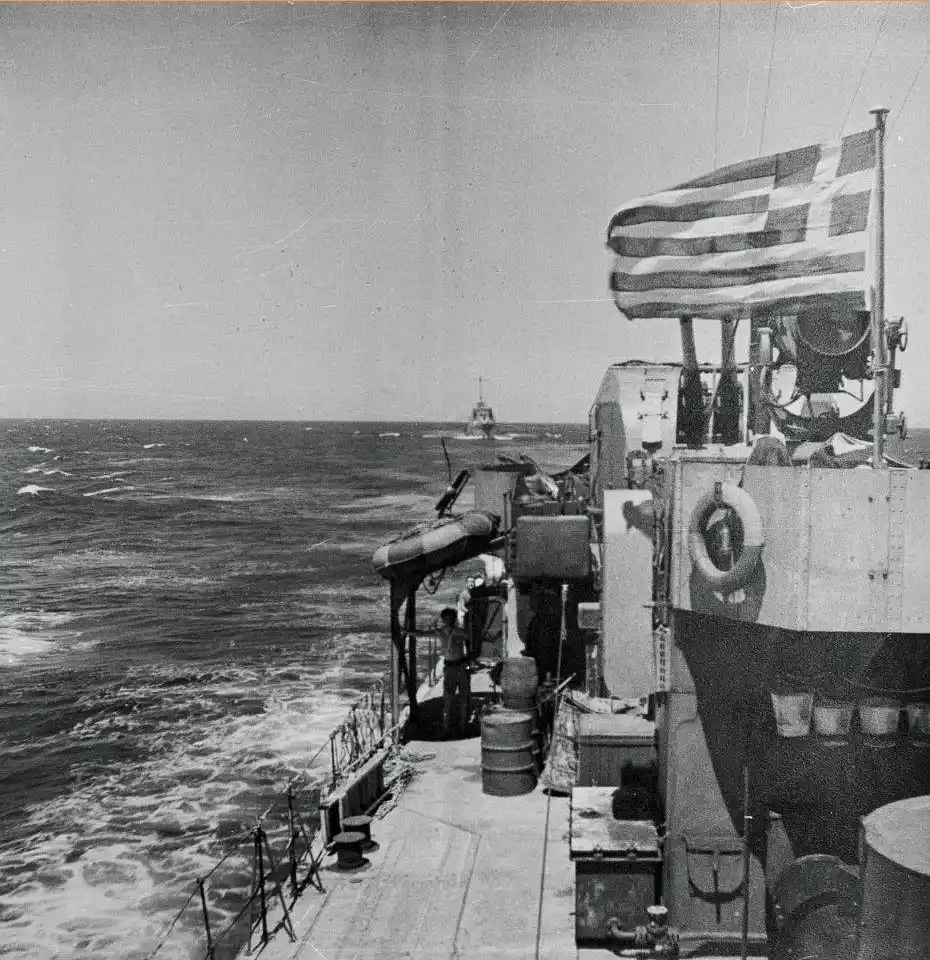
In June 1943, “VASILISSA OLGA” participated in the operations to capture the islands of Pantelleria and Lampedusa, to open the way to Sicily. During the bombardment of Pantelleria, “VASILISSA OLGA” sank an enemy landing craft and with its artillery forced a coastal gun battery, which was firing its shells very close to it, to fall silent. Here it is worth mentioning a characteristic moment. One of the battery’s shells whistled past the bridge of “VASILISSA OLGA”, so everyone there instinctively ducked. Blessas, who had also ducked, looked around and with his usual ironic smile said, “Well done, we all ducked.”
On July 10, 1943, “VASILISSA OLGA” participated in the huge amphibious operation “HUSKY”, the Allied invasion of Sicily. On September 10, 1943, she participated in the British Naval Force to which the Italian Fascist Northern Fleet surrendered, while on the same day the surrender of the Italian Southern Fleet was attended by the equally famous for its action destroyer “ADRIAS”, commanded by Commander I. Toumbas. On September 16, 1943, she participated in the British Force that led the surrendered Italian Fleet to Alexandria for disarmament. These honorable historical moments experienced by Blessas and the crew of “OLGA” had the grandeur of a just historical mandate.
After these dramatic moments, “VASILISSA OLGA” was used in operations in the Dodecanese. On the night of September 17-18, 1943, together with the British destroyers “FAULKNOR” and “ECLIPSE”, they sank an important German convoy transporting personnel in the Karpathos Strait, consisting of a transport, an oil tanker, and a torpedo boat. In this engagement, Blessas was particularly harsh on his opponents, something that was not usual for him. It is speculated that the reason was the sinking of the Greek submarine “KATSONIS” by the Germans three days earlier, whose commander was Lieutenant Commander Laskos, a close friend of Blessas. More information about this engagement is not available due to the fact that the relevant data was lost during the sinking of “OLGA”.
On September 22, 1943, “VASILISSA OLGA”, carrying supplies and personnel, sailed with the British destroyers “FAULKNOR” and “ECLIPSE” to Leros, which had been liberated a few days earlier by British and New Zealand commandos (SBS – LRDG) and a section of the Greek Sacred Battalion (Zakharakis patrol).
At this point, it is worth mentioning a small story involving Blessas. Many of the island’s residents visited the ship, whose crew offered them plenty of food and personal items, even clothes. Upon the residents’ return to the port, the Italian customs officials asked them for duties on these items, so the residents returned to “OLGA” to complain to Blessas. What Blessas told the Italian customs officers is easy to guess, considering that afterwards, not only did they dare not ask for duties again, but they also helped the residents unload their things from the boats.
On September 26, at 07:00, “VASILISSA OLGA”, together with the British destroyer “INTREPID”, sailed to Lakki, Leros, where its fateful and glorious end awaited them. At 10:00, 20 to 24 German Junkers Ju 88 bombers, in formations and in waves, attacked the two destroyers. The alarm was raised and the crew ran to their battle stations, while Blessas, in order not to delay at all, rushed to the ship’s bridge without his shoes.
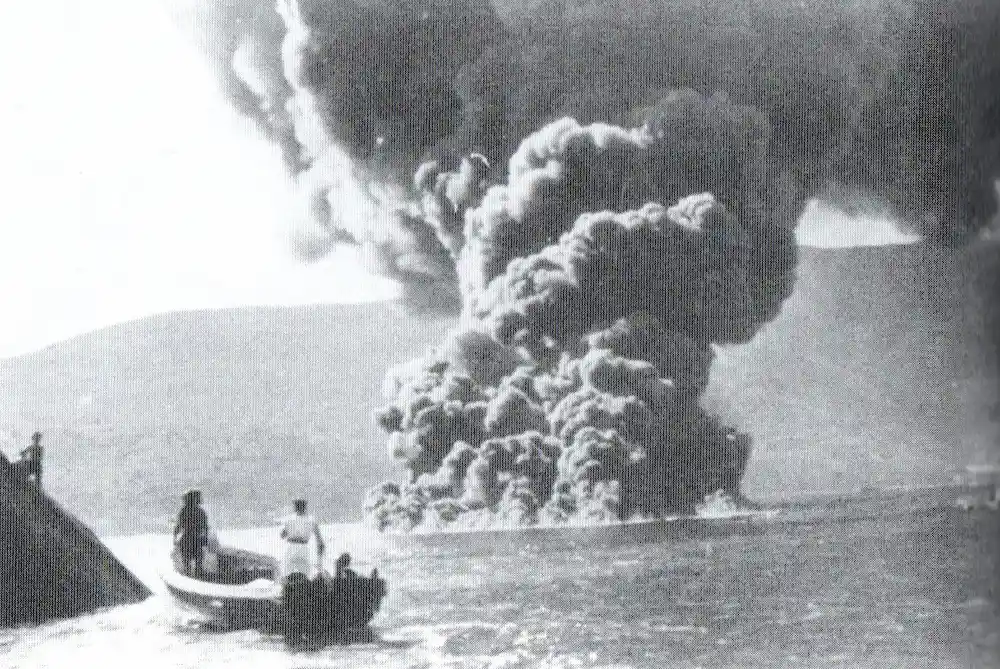
Blessas would be the first casualty of the “V. OLGA” and among his last words were “it’s nothing, kids, we’ll get over this”. Retired Admiral P. Fokas writes the following about the last moments of “VASILISSA OLGA”: “The heroic commander of the ship, G. Blessas, while heading towards the bridge, giving orders on the way and encouraging everyone with his usual composure, was hit by a burst of machine gun fire and fell dead… Within a few minutes, the severed stern section of the beautiful ship sank amid a sky-high column of flames and thick smoke, while the bow slowly capsized, to sink in turn. The time was 10:14. A few minutes before the order “Abandon ship” was given and only then did the crew of “OLGA” abandon it. Apart from the Commander and the Executive Officer, 4 more Officers, 15 Non-Commissioned Officers and 50 Sailors lost their lives following their ship to the watery grave.”
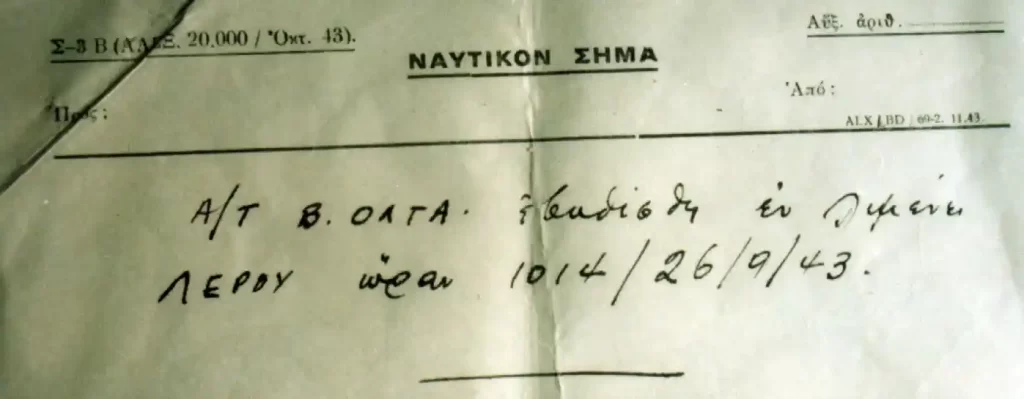
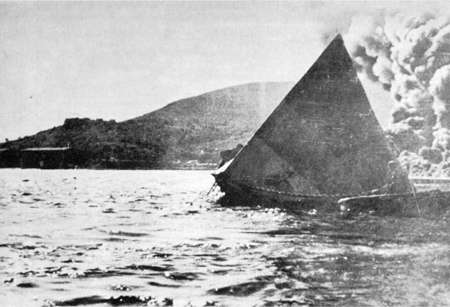
The brilliant Commander, Lieutenant Commander Blessas, the heroic staff, and the brave sailors showed an excellent heroic stance until the last moment of their fateful end, either their own or that of the ship. For these reasons, Blessas was posthumously promoted to the rank of Commander and awarded the Gold Cross of Valor.

In a personal letter to his brother Kanaris, who lived in Ethiopia, on September 1, 1943, just a few days before he was killed, Blessas expressed his concern about the possible developments in Greece after the imminent, as he saw it, liberation. He writes: “I hope very much to be able to rest in Greece very soon, everything indicates that only a few, very few months separate us from Greece. Information about the political squabbling in the Middle East and Greece will certainly reach you where you are.” And after expressing his disgust for the apparent “saviors” of Greece, he concludes: “…where we will end up I don’t know, but I must say that I am not at all optimistic about the future… I don’t see how there will be peace, which we need so much. As for me, I have finally decided not to stay in the Navy for even one day after the end of the war. It will be a shame, I think, after three years of war, to be forced to take part in a Greek-Greek War…” Blessas’ concerns and future predictions were, unfortunately, fully confirmed both in terms of events and time. All except one. The one concerning his personal fate…
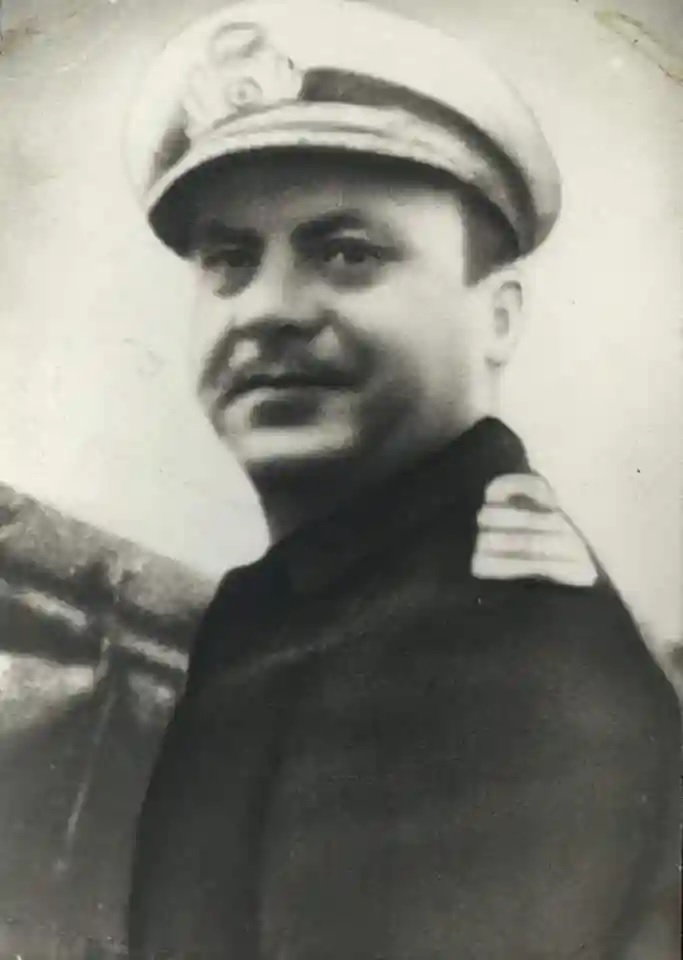
His colleagues have said of Blessas that he was an excellent and experienced officer. That he was very good at handling the ship and as an example it was mentioned that “VASILISSA OLGA” entered the port of Sliema, Malta at 25 knots, while the British watched the maneuvers in amazement. That he was very formal and service-oriented. According to one view, which we have a duty to mention, he was more strict, formal, and service-oriented than was customary. That he had a good character and was kind and just. That when his ship was traveling, he would stay on the bridge continuously, or at most in the chart room, silent and expressionless under the weight of his responsibilities. In the port, however, he was good-natured, smiling, everyone agrees on his kind broad smile and affectionate towards his sailors, who respected and loved him.
George Blessas (Naval History Service)] Others mention as an example of his sensitivity and assumption of responsibility, the accident in the port of Benghazi, for which he requested and investigations were carried out to assign blame, and they remember that he was so affected by that event that for many days he was so upset that he didn’t even leave his cabin. A particular impression was caused by the simple and laconic style with which he narrated the operations of “VASILISSA OLGA” when asked by his colleagues, as well as his absolute composure and automatic and always correct reactions, even in the most difficult moments. As for Blessas’ private life, a simple description, I think, encompasses it all. Both by family tradition and by character, he was a true patriot. All his colleagues agree that, above all, Blessas was the absolute embodiment of duty. Blessas bequeathed to the history of the Navy the concept that duty has no alternatives. For the heroic dead of “VASILISSA OLGA”, her Commander, Officers, Non-Commissioned Officers and Sailors, but also for this glorious ship, Retired Rear Admiral E. Sakellarios quotes in his letter, verses from the “Fourth Ode – To the Sacred Battalion” by Andreas Kalvos: “Fate snatched the victorious laurel from you, and wove you a mournful cypress wreath from myrtle. But if anyone died for the homeland, myrtle is a priceless leaf, and the branches of the cypress are good.






